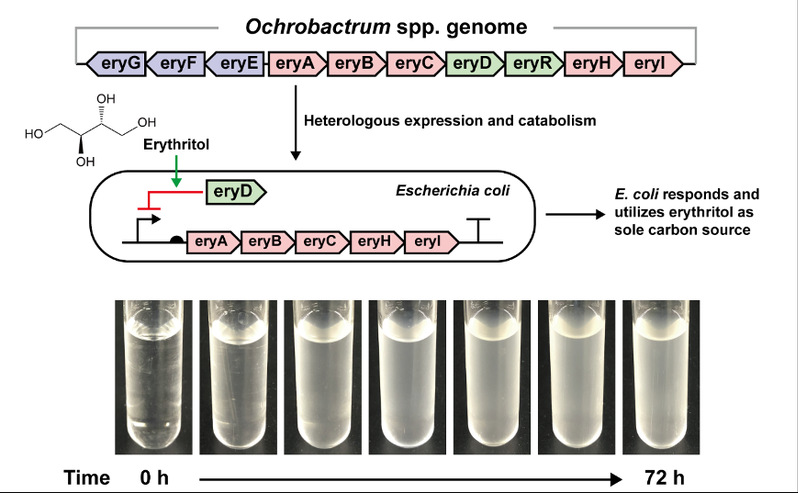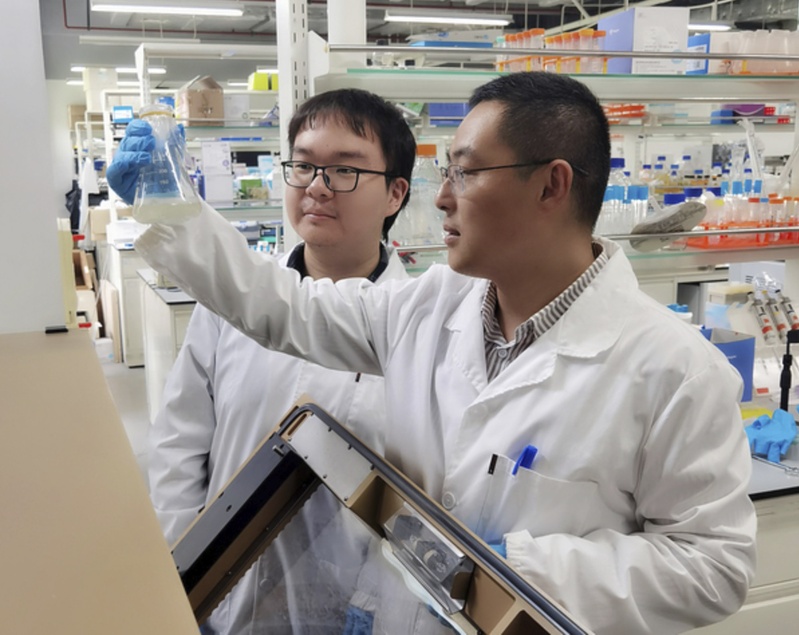Erythritol is a C4 sugar alcohol that naturally exists in some vegetables, fruits, mushrooms, and fermented foods. Because of its stable physical and chemical properties, low price, high biological safety, and the fact that it cannot be metabolized by the human body, erythritol is widely used in the food industry as a natural sugar substitute (such as in sugar-free sodas). Due to the lack of erythritol metabolic/degradation pathways in organisms, it is generally excreted as carbon waste after entering the human body or many other organisms. In metabolic engineering and synthetic biology, erythritol could be potentially utilized as the sole carbon source by Escherichia coli (E. coli) which can be engineered to produce a wide range of valuable products. Conventionally, the cultivation of E. coli in the laboratory is primarily dependent on easy-to-use carbon sources like glucose (C6), as well as C1-based carbon sources such as CO2 and methanol. However, the use of C4-based carbon sources such as erythritol for E. coli cultivation has not been reported as yet.
Recently, Assistant Professor Li Jian’s research group in SPST achieved significant progress in the utilization of erythritol as the sole carbon source by E. coli. The results were published in an article entitled “Engineering Escherichia coli to Utilize Erythritol as Sole Carbon Source” in the journal Advanced Science.
In this study, the researchers identified an erythritol metabolic pathway, including five enzymes which are eryA, eryB, eryC, eryH, and eryI, and reconstituted the pathway in E. coli, where several strains were engineered to utilize erythritol as the sole carbon source, enabling the strains to grow with erythritol as the sole carbon nutrient in a synthetic medium. They then identified the transcriptional regulatory protein eryD and its DNA binding sequence in response to erythritol for the first time. They also extended this regulatory element to engineer other genetic circuits that can be regulated by erythritol. In two demonstration experiments, the researchers showed that the engineered E. coli strains can be used as living detectors to distinguish erythritol-containing soda soft drinks, and can grow in a simulated intestinal fluid supplemented with erythritol that provides a research basis for live therapy.

The engineered E. coli grows with erythritol as the sole carbon source
This study demonstrated the success of inserting the erythritol metabolic pathway in E. coli, allowing cells to respond and use erythritol as the sole carbon source. Such success might be expanded to other heterologous hosts for more applications, if an erythritol-responding and/or utilizing system is needed, for example, in the areas of synthetic biology, metabolic engineering, and biomedical engineering.
Second-year Ph.D. student Ba Fang is the first author of this paper. Prof. Li Jian is the corresponding author. ShanghaiTech University is the sole affiliation.

Ba Fang (left) and Li Jian (right) in the lab
**This article is provided by Prof. Li Jian and edited by ShanghaiTech Global

